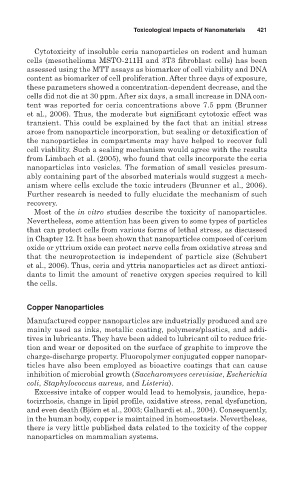Page 441 - Environmental Nanotechnology Applications and Impacts of Nanomaterials
P. 441
Toxicological Impacts of Nanomaterials 421
Cytotoxicity of insoluble ceria nanoparticles on rodent and human
cells (mesothelioma MSTO-211H and 3T3 fibroblast cells) has been
assessed using the MTT assays as biomarker of cell viability and DNA
content as biomarker of cell proliferation. After three days of exposure,
these parameters showed a concentration-dependent decrease, and the
cells did not die at 30 ppm. After six days, a small increase in DNA con-
tent was reported for ceria concentrations above 7.5 ppm (Brunner
et al., 2006). Thus, the moderate but significant cytotoxic effect was
transient. This could be explained by the fact that an initial stress
arose from nanoparticle incorporation, but sealing or detoxification of
the nanoparticles in compartments may have helped to recover full
cell viability. Such a sealing mechanism would agree with the results
from Limbach et al. (2005), who found that cells incorporate the ceria
nanoparticles into vesicles. The formation of small vesicles presum-
ably containing part of the absorbed materials would suggest a mech-
anism where cells exclude the toxic intruders (Brunner et al., 2006).
Further research is needed to fully elucidate the mechanism of such
recovery.
Most of the in vitro studies describe the toxicity of nanoparticles.
Nevertheless, some attention has been given to some types of particles
that can protect cells from various forms of lethal stress, as discussed
in Chapter 12. It has been shown that nanoparticles composed of cerium
oxide or yttrium oxide can protect nerve cells from oxidative stress and
that the neuroprotection is independent of particle size (Schubert
et al., 2006). Thus, ceria and yttria nanoparticles act as direct antioxi-
dants to limit the amount of reactive oxygen species required to kill
the cells.
Copper Nanoparticles
Manufactured copper nanoparticles are industrially produced and are
mainly used as inks, metallic coating, polymers/plastics, and addi-
tives in lubricants. They have been added to lubricant oil to reduce fric-
tion and wear or deposited on the surface of graphite to improve the
charge-discharge property. Fluoropolymer conjugated copper nanopar-
ticles have also been employed as bioactive coatings that can cause
inhibition of microbial growth (Saccharomyces cerevisiae, Escherichia
coli, Staphylococcus aureus, and Listeria).
Excessive intake of copper would lead to hemolysis, jaundice, hepa-
tocirrhosis, change in lipid profile, oxidative stress, renal dysfunction,
and even death (Björn et al., 2003; Galhardi et al., 2004). Consequently,
in the human body, copper is maintained in homeostasis. Nevertheless,
there is very little published data related to the toxicity of the copper
nanoparticles on mammalian systems.

